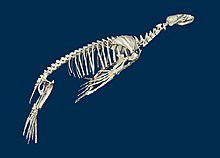Skeleton
There are several types of skeletons, including the exoskeleton, which is a rigid outer shell that holds up an organism's shape; the endoskeleton, a rigid internal frame to which the organs and soft tissues attach; and the hydroskeleton, a flexible internal structure supported by the hydrostatic pressure of body fluids.Invertebrates are other animals that lack a vertebral column, and their skeletons vary, including hard-shelled exoskeleton (arthropods and most molluscs), plated internal shells (e.g. cuttlebones in some cephalopods) or rods (e.g. ossicles in echinoderms), hydrostatically supported body cavities (most), and spicules (sponges).Arthropods have exoskeletons that encase their bodies, and have to undergo periodic moulting or ecdysis as the animals grow.Endoskeletons are the internal support structure of an animal, composed of mineralized tissues, such as the bone skeletons found in most vertebrates.[4] They vary in complexity from functioning purely for support (as in the case of sponges), to serving as an attachment site for muscles and a mechanism for transmitting muscular forces.Pliant skeletons are capable of movement; thus, when stress is applied to the skeletal structure, it deforms and then regains its original shape.[7] Rigid skeletons are not capable of movement when stressed, creating a strong support system most common in terrestrial animals.Hydrostatic skeletons are flexible cavities within an animal that provide structure through fluid pressure, occurring in some types of soft-bodied organisms, including jellyfish, flatworms, nematodes, and earthworms.The cytoskeleton is not a skeleton in the sense that it provides the structural system for the body of an animal; rather, it serves a similar function at the cellular level.Bones also produce red and white blood cells and serve as calcium and phosphate storage at the cellular level.Several attributes of the shape and structure of the bones are optimized to endure the physical stress associated with flight, including a round and thin humeral shaft and the fusion of skeletal elements into single ossifications.The skeleton, which forms the support structure inside the fish is either made of cartilage as in the Chondrichthyes, or bones as in the Osteichthyes.[4] To facilitate the movement of marine mammals in water, the hind legs were either lost altogether, as in the whales and manatees, or united in a single tail fin as in the pinnipeds (seals).[20] The skeleton consists of both fused and individual bones supported and supplemented by ligaments, tendons, muscles and cartilage.[23] The human skeleton takes 20 years before it is fully developed, and the bones contain marrow, which produces blood cells.[27] The cuticle covers the animal's body and lines several internal organs, including parts of the digestive system.Arthropods molt as they grow through a process of ecdysis, developing a new exoskeleton, digesting part of the previous skeleton, and leaving the remainder behind.[5] The skeletons of echinoderms, such as starfish and sea urchins, are endoskeletons that consist of large, well-developed sclerite plates that adjoin or overlap to cover the animal's body.The stereome structure is porous, and the pores fill with connective stromal tissue as the animal ages.[30] Cartilage is a connective skeletal tissue composed of specialized cells called chondrocytes that in an extracellular matrix.



Human skeletonSkeleton (disambiguation)Australian MuseumAnatomical terminologystructural frameanimalsexoskeletonendoskeletonorganssoft tissueshydroskeletonhydrostatic pressurebody fluidsVertebratesvertebral columncartilagesInvertebratesarthropodsmolluscscuttlebonescephalopodsossiclesechinodermscavitiesspiculesspongesconnective tissueAncient Greekcartilagecuticlehydrostatic skeletonsmoultingecdysisshellssensory perceptionsouthern giant clamPacific OceanSyrinx aruanusmineralized tissueschordatesstressbivalve shellsmesogleacnidariansjellyfishmuscleproteinspolysaccharidesterrestrial animalsbarnaclechitincalciumcalcium carbonatestony coralsmolluskssilicatediatomsradiolariansHydrostatic skeletonsoft-bodied organismsflatwormsnematodesCytoskeletonflagellalamellipodiavesiclesorganellesThomas HuxleyEvidence as to Man's Place in Naturemammalscartilaginous fishessharkssegmentalmuscle contractionhydroxyapatiteosteoblastsosteoclastsosteocytesmineralized tissuehoneycomb-likewhite blood cellsbone marrowendosteumperiosteumnervesblood vesselsembryonic developmentperichondriumLigamentstendonssnakescaeciliansflighthumeral shaftossificationsegg toothFish boneChondrichthyesOsteichthyesCalifornian sea lionmarine mammalsmanateestail finpinnipedscervical vertebraeLeonardo da Vincimusclesspinal cordstapesmiddle earpelviscraniumhyoid bonetonguehip boneswormian bonesaxial skeletonappendicular skeletonmarrowearthwormsArthropod exoskeletoninsectscrustaceansarachnidsepidermisremainder
